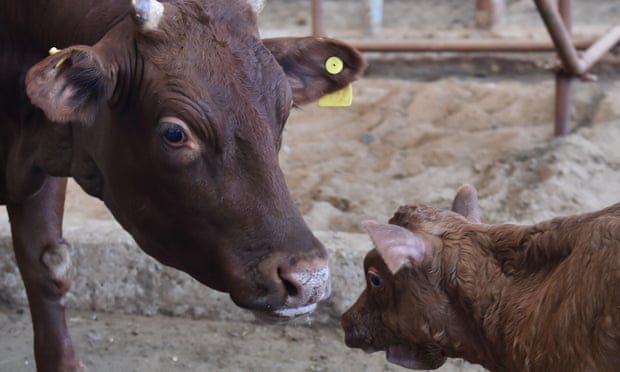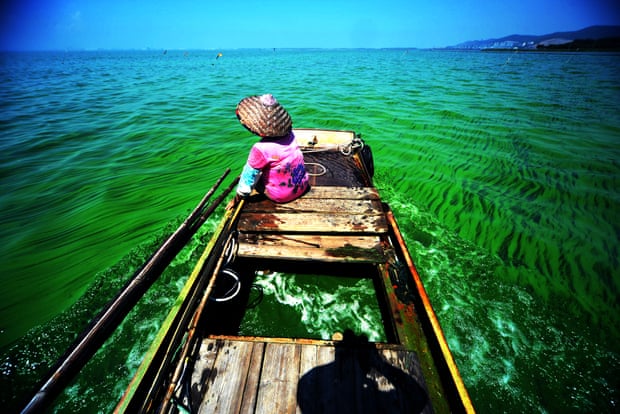 |
| Niu Niu, a genetically modified cow, is seen with its calf at the experimentation base of Beijing University of Agriculture. Photograph: Li Wen/Alamy |
A biotech consortium in China has announced that it intends to open a facility near Beijing with the aim of cloning up to a million cows a year to meet the country’s growing demand for beef. The factory won’t stop at cows. It also plans to clone racehorses, pets and even sniffer dogs. But the vast majority of animals it produces will be calves for meat production.
In Beijing I read this news with incredulity and dismay. In 2009, I directed the first documentary about China’s rising consumption of meat and the growing industrialisation of its food sector, including livestock production. In the film, What’s for Dinner?, I explored a nexus of problems related to intensive animal agriculture: environmental pollution, food security, public health (including the use of antibiotics and hormones in feed), climate change and animal welfare.
Since then, I’ve promoted public awareness on these issues, screening the film around China and employing popular social media platforms. We’re attracting more attention from a growing number of people concerned about the environmental and moral implications of eating animal products.
Unfortunately, meat production and consumption in China continue to rocket. The country is already the world’s top producer of meat; on average, each person consumes about 60kg a year (mainly pork, plus chicken and beef). In the US, each person eats almost twice as much meat as someone in China. But since China has four times as many people, overall it consumes about double the meat eaten in the US.
The world’s governments and thousands of civil society representatives are meeting in Paris to confront the challenge of climate change. The Chinese government wishes to be a global leader, greening its energy sources and reducing its greenhouse gas emissions.
Beijing is acutely aware of how unhappy we citizens are to breathe the smog in our cities or smell the foul odours of our polluted rivers. Yet, by expanding exponentially our commitment to intensive animal agriculture, China will increase emissions of methane, carbon dioxide and another potent greenhouse gas, nitrous oxide, which has nearly 300 times the warming power of carbon dioxide.
The project to clone cows is a response to increasing demand for beef and China’s urge to compete with agribusinesses overseas. (In 2014, China produced 11.5% of the world’s beef, nearly 7m tonnes , according to the US Department of Agriculture.) Traditionally, beef wasn’t a staple in local cuisine in most parts of China. In the south of the country, where I grew up, oxen and buffaloes were more valuable alive; they were how rural families sustained their livelihoods.
It was only in my teenage years, in the late 1980s, that I had my first taste of beef. Then, and even more so now, beef represents the affluence and abundance of the western diet. This diet, in the form of burgers and fried chicken in fast-food restaurants, and high-end steaks, has spread across China over the past two decades.
It is ironic that China should be embracing so wholeheartedly western food habits along with capitalism. For all their scientific novelty, these cloned cows (should they materialise) will probably still end up on industrial-scale factory farms. The facilities are already notorious for the dangers they pose to human health via zoonotic diseases.
Given that cloned animals share the same genes, they have even higher risks of succumbing when diseases strike. China’s pigs were recently subject to global scrutiny for harboring drug-resistant strains of bacteria. This came about because of producers’ overuse of the antibiotics that enable densely packed animals to fend off infections and grow bigger, faster. So extensive is the abuse of antibiotics in Chinese and global animal agriculture that some scientists believe the world may be entering a “post-antibiotic era” in which antibiotics used to treat common human illnesses will have lost their power to cure.
Of course, we might ultimately clone farmed animals that no longer need antibiotics. However, genetically engineered food has met with resistance from the Chinese public in recent years. It is possible to imagine that the beef from these cloned cows will receive even greater hostility (unless the factory manages to hide the source of its animals).
Even if these animals survive disease and public rejection, they will still need to eat, and will still produce waste and climate-warming methane. China, like every other country that has adopted the western-developed, factory-farming model, generates more animal waste than it can handle. Some of it makes its way into our waterways and lakes – half of which are already severely polluted by industrial effluent and chemical fertilizers. And industrial agriculture is now responsible for a larger share of China’s water pollution than industrial factories. If we massively increase our animal production, what will we do with the lagoons of manure? How will we protect our precious potable groundwater, or keep enough of it for us – especially when a beef cow, depending on its stage of growth, consumes up to 27 gallons of water a day.
(Cows raised for beef are the most resource- consuming and greenhouse gas-emitting of all farmed animals.) Parts of China are already water-insecure, and the government is spending billions of dollars to channel fresh water from the south to China’s more industrialized north.
 |
| Algae in the water of Lake Taihu has compromised drinking water for millions of people in China’s Jiangsu province. Photograph: Rex/Imaginechina |
If we massively increase our animal production, what will we do with the lagoons of manure? How will we protect our precious potable groundwater, or keep enough of it for us – especially when a beef cow, depending on its stage of growth, consumes up to 27 gallons of water a day. (Cows raised for beef are the most resource- consuming and greenhouse gas-emitting of all farmed animals.) Parts of China are already water-insecure, and the government is spending billions of dollars to channel fresh water from the south to China’s more industrialized north.
One of the routes will bring water to Beijing and Tianjin, where the cloning factory will be built. Tianjin is already experiencing drought. Are we really planning to take river water from the south and give it to cows so that the newly rich can eat more beef? Tianjin is also where several deadly explosions at a chemical warehouse in August claimed the lives of more than a hundred people and spewed large quantities of toxic chemicals into surrounding neighbourhoods.
The Chinese government is acutely aware of food insecurity (it has a strategic pork reserve in case supplies are constrained). With the world’s largest population, a recently relaxed family planning policy, and an economy that threatens to exhaust our finite natural resources, it is not difficult to envision a future China where farmed animals compete for the little land and even less water remaining.
Our country used to have enough grain to feed itself. Now we have become the world’s largest importer of soybeans – nearly all of which go to feed animals. In 2013-14, imports of soybeans (mainly from the US and Brazil) totalled 70.4m tonnes , almost six times the level of domestic production. Corn imports are rising, too. Does China want to rely even more heavily than it already does on the economic and political stability of foreign countries in order to obtain commodity crops?
Enormous factories such as the one in Tianjin will lead to reduced space and greatly compromised animal welfare for cows. The health of the people who eat them will also be compromised. It will only be a matter of time before more animals are cloned, as long as it makes profit. If they are imperfect, they will be slaughtered or discarded on a scale virtually unprecedented in human history.
It is hard to imagine this commercialisation of science wouldn’t be subject to protests or regulatation by western governments. But China’s helter-skelter commitment to capitalism and its lack of genuine “cultural conservatism” reflects a marginalisation of values that society used to hold dear, such as Confucian harmony, Daoist concerns for nature, and the Buddhist honouring of all life.
China no longer needs to replicate the worst excesses of the west. We have a responsibility to our country, our natural resources, the global climate and our own consciences to stop this madness before it is too late.










No comments:
Post a Comment